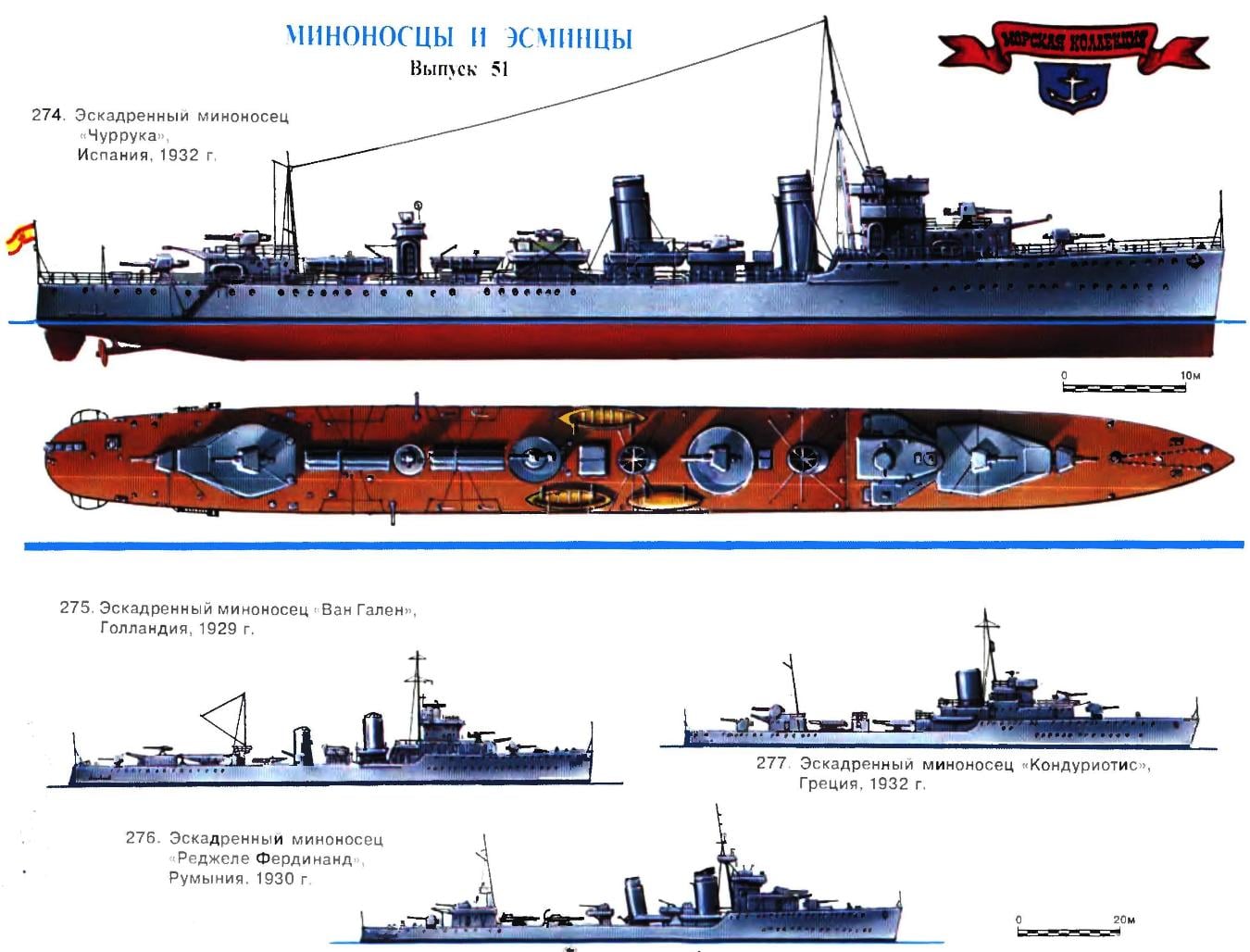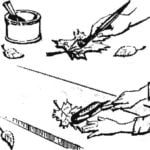 In countries which are called “Maritime powers of the second tier”, you can see two diametrically opposite approaches to creation of own torpedo ships. Some tried to build world’s most powerful superessence remaining, as a rule, in a single instance; one of them belonged to Yugoslavia and Poland (about which we told in the previous issue of the journal). Other countries, on the contrary, gave preference to low-cost destroyers with modest combat capabilities, but that it was possible to build a small but still lots.
In countries which are called “Maritime powers of the second tier”, you can see two diametrically opposite approaches to creation of own torpedo ships. Some tried to build world’s most powerful superessence remaining, as a rule, in a single instance; one of them belonged to Yugoslavia and Poland (about which we told in the previous issue of the journal). Other countries, on the contrary, gave preference to low-cost destroyers with modest combat capabilities, but that it was possible to build a small but still lots.
As the initial sample for copying is looked British destroyers “alphabetical” series (see “modelist-Konstruktor” No. 2, 2001). Despite their very mediocre characteristics, they are distinguished by reliability, simplicity of operation, good seaworthiness and, importantly, low cost. Not the last role here was played by the high authority of great Britain as “mistress of the seas”. Anyway, but in the interwar period of the English shipyards were out of the competition. In the years 1928-1939 they built for export 20 destroyers: ten for Argentina (the three “Mendoza” and seven of the “Buenos Aires”), six for Chile (“Serrano”), two for Greek (such as “Vasileos Georgios”) and two for Portugal (“Wagga”). Ten ships — six for Brazil and four for Turkey — were ordered before the war; they were later requisitioned for Royal Navy (with the exception of two Turkish type “De mirgissa”, which in 1942 still went to the customer). In addition, five destroyers were built by English drawings and English help in Portugal, and two of them are already on the stocks were sold to Colombia.
All of these ships both in appearance and in characteristics mostly repeating English destroyers “alphabetical” series. Total displacement of most of them was in the range of from 1600 to 2000 tons, speed of 35-36 knots, armament consisted of four 120mm guns, one or two anti-aircraft guns and two three-pipe (at least four) 533-mm torpedo tubes. Several differed only in Argentina “Mendoza” (they were larger and had five 120-mm guns) and Chilean-type “Serrano” (which had, on the contrary, smaller and only armed with three 120-Milli-meters sets). In addition, the Greek destroyers were installed not English, and German 127 mm gun.
The closest relatives of the British “alphabet” was all the Dutch destroyers of the interwar period. Getting 20 years to modernize its fleet, the naval command of the Netherlands has decided not to “reinvent the wheel” and do not try to create their own project, and contact the lead developer, torpedo ships — firm “yarrow”. Four destroyers of the type “van Ghent” was built at the Dutch shipyard in 1925. By design, they repeated English”, Ambasad”, differing only in artillery (they were mounted 50-caliber 120-graph paper “Bofors”) and fire control system. In addition, an unusual feature of these ships was the presence of a seaplane “Fokker”, mounted on a special platform behind the mainmast. According to the Dutch admirals, reconnaissance aircraft could be very useful in the Maritime theater in the East Indies, with its vast waters and many Islands.
After the first four destroyers followed by a second — type “van Galen”. They are almost exactly the same as its predecessors, but equipped with more modern boilers with higher steam parameters and increased by 30 tons of fuel. Externally, Dutch destroyers differed from the “English” bit displaced aft of the bow pipe and shields 120-mm guns (due to the fact that “borsovska” guns were heavier than the British, shields had to do easier, and besides, they mounted only two guns — the first and fourth).
The last series of Dutch destroyers built before the war were four ships of the “Gerard Callenburg”, founded in 1938-1939. Their project was developed, again with the help of the firm “yarrow” and largely repeated its predecessors. However, the new ships were larger and carried a different armament. Torpedo tubes four-pipe steel, the number of trunks 120-mm guns increased to five, and two units were coupled, and the third — sublime — odnorodnoi. The length of the barrel of guns was reduced to 40 calibers, but increased the angle of elevation that allows their use as anti-aircraft. An important novelty was the appearance of the vehicle coupled 40-mm guns “Bofors” — the most effective air defenses of the time. However, actually the staff weapons had received only a head destroyer “Gerard Callenburg”, which never came into operation, was scuttled by the crew after the German invasion of the Netherlands. He was later raised by the Germans and introduced in the composition of the Kriegsmarine under the designation ZH-1. In June 1944 it was sunk by torpedoes of the British destroyers Tartar and Ashanti.
A second similar ship, “Isaac Sweers”, in may 1940, was able to tow in an unfinished form in England. A year later he was commissioned, but with the weapons of the three British paired 102-mm anti-aircraft installations and radar. The destroyer was active side by side with Royal Navy and was sunk in February 1942 in the Mediterranean German submarine U-431. The other two ships of the series on the stocks went to the Germans, but never completed.
Very interesting “pedigree” of the Romanian destroyers type “Regele Ferdinand” — the most powerful warships of the Navy of this country. When in the mid 20-ies of the Romanian government allocated funds for the construction of two modern destroyers, entered into a contract with the old contractor — the Italian company “Pattison”, because the Romanian Navy already had two destroyers of the type “Maresti”, built at this shipyard during the First world war. As a private company, “Pattison” not too pampered orders for the Italian Navy, and because of this, the firm continued to develop projects of ships in cooperation with British colleagues (the leading Italian shipbuilders from such a partnership has long been abandoned). In this case, as the prototype of the Romanian destroyer chose the English leader, “Shakespeare”, built in 1918. However, the project has made a number of significant changes; perekomponovkoy machine-boiler compartment, the average 120-mm gun was moved over the second pipe, set tips of the mast. Artillery took the same as on the Dutch destroyers — Swedish 120-mm cannon “Bofors” with a barrel length of 50 calibers. Rangefinders and fire control system supplied by German company “Siemens”. In General, for its time, “Regele Ferdinand” looked quite a modern military unit and due to the “international” improvement was significantly superior to its English prototype.

274. Destroyer “Churruca”, Spain, 1932
The second ship with the same name, inherent is sold to Argentina. Built in the Spanish shipyard in Cartagena. Displacement standard, t 1536, 2087 full t Length overall 101.5 m, width of 9.68 m, draught 3.2 m. Capacity twin-shaft steam turbine 42 000 HP, speed 36 knots. Armament: five 120-mm guns, one 76-mm antiaircraft cannon, four machine guns, two three-pipe 533-mm torpedo tubes. Just 1927-1951 18 years built several different ships, including two for Argentina.
275. Destroyer “van Galen”, Holland, 1929
The lead ship of the second series of destroyers of the type “van Gent”. Built in Holland at the shipyard “Feyenord”. Displacement standard 1316 tons, 1650 T. fuller Length overall 98,15 m, width at 9.53 m and draft of 2.97 m. Capacity twin-shaft steam turbine 31 000 HP, speed 36 knots. Armament: four 120-mm guns, one 75-mm antiaircraft gun, four 40-mm machine gun, four machine guns, two traktornyh 533-mm torpedo tubes. Only in the years 1928-1931 the construction of eight units in two slightly different batches.
276. Destroyer “Regele Ferdinand”, Romania, 1930
Built in Italy at the shipyard “Pattison”. The standard displacement of 1400 tons, full Length 1850 T. most 101,9 m, width 9.6 m, draught 3,5 m. Capacity twin-shaft turbine plant of 52,000 HP, a speed of 37 knots. Armament: five 120-mm guns, one 76-mm anti-aircraft gun, two 40-mm machine gun, two three-pipe 533-mm torpedo tubes. Just built two units.
277. Destroyer “Conduritol”, Greece, 1932
Built in Italy at the shipyard “the Oder”. The standard displacement of 1389 g full 2050 m. maximum Length 96 m, width of 9.75 m, draft of 3.65 m. Capacity twin-shaft steam-turbine engines of 44,000 HP, speed 38 knots. Armament: four 120-mm guns, three 40-mm machine gun, two three-pipe 533-mm torpedo tubes. Just 1932-1933 built four units.
The British roots are easy to discern in the design of all destroyers of the Spanish Navy, built in the Iberian Peninsula until the early 50-ies. Destroyers type “Churruca” was an almost copy of the English leader Scott — analogue and contemporary “Shakespeare”. The first two series of Spanish descendants different from their “ancestor” but a few details — increased by 5 percent increased capacity Yes fuel capacity. Interestingly, under construction at the shipyard in Cartagena for the first two ships — “Churruca” and “alcalá Galiano” — immediately after the descent to the water was overbought Argentina, and to replace them laid a new pair under the same names.
The first series of seven destroyers of the type “Churruca” followed by a second, also of the seven units. The ships proved themselves as very successful, and in 1936 decided to build a third series, however, to implement these plans was prevented by the civil war. The construction of the last two ships of the family was delayed, and in the end, “álava” and “Liners” was commissioned only in 1951! Included in their design changes looked very small; tips of the mast and slightly increased anti-aircraft armament was installed in place of one 120-mm guns, could not hide the obvious antiquity of the project. In fact, the ships represented the British “Scott” during the First world war and at the time of entry into service was so archaic that it was almost immediately sent back to the shipyard for a major conversion to anti-submarine frigates.
The second after the UK European “trendsetter” class destroyers in the interwar years was considered Italy, and it is therefore not surprising that the products of the shipbuilding of this country on the foreign market enjoyed a certain popularity. In addition to Romania, the destroyers on the Italian shipyards were ordered by Greece and Turkey. The contract to build four ships of the type “Condorito” was signed with Greece in October 1929. The project was developed on the basis of the latest Italian destroyer “Frecce”, but at customer’s artillery armament consisted of four 120 mm guns in single, not paired units (in silhouette “Condorito” is very reminiscent of the Soviet “seven”). However, due to the greater weight of artillery had to abandon heavy command-ranging posts, limiting easy open finder on bow superstructure.
Two pairs of Turkish destroyers were built simultaneously with Greek, but their project was based on the same prototype. Two ships of the “Zafer” bore 120-mm artillery is similar to the “Italians,” in two coupled systems, a type of destroyer “Kocatepe” is a four odnorodnyh. The ships were equipped with a completely modern fire control system, but different from “Frecce” several low-power mechanisms. In addition, they had a more traditional twin-tube silhouette — one-pipe destroyer in that time seemed too extravagant.
In addition to the construction of destroyers in the order, the Italians sold six ships from its fleet. Two destroyers built in 20-ies of the type “Quintino Sella” in 1940, Sweden purchased, and four more of the old “esploratori” in 1937 came under the flag of Spain. However, it was “second hand”, not representing any special value.
The fate of many destroyers of the third world countries was tragic. Spanish ships of the type “Churruca” took an active part in the civil war. At first they were all on the Republican side, but gradually one after another — often in corrupted form, fell into the hands of Franco. “The Almirante Ferrandis” in September 1936, was destroyed by artillery heavy cruiser “Canarias”. But a year and a half later, the Republican fleet fully revenged of their enemies: destroyers “Sanchez barcaiztegui V.”, “Almirante Antequera” and “Lepanto” managed to get in a classic torpedo attack and send it to the bottom of the heavy cruiser “Baleares”. In March of 1939 “Sanchez barcaiztegui V.” was sunk in the Harbor of Cartagena, Franco’s air force, but later it was raised and restored.
The biggest losses were suffered, the Dutch fleet: all ten were part of it destroyers were killed during the Second world war. Basically, they were victims of the Japanese fleet during the battle in the Dutch East Indies. To implement its offensive capabilities as a torpedo ships they failed, but “KOR-tener” he was sunk by a torpedo from heavy cruiser “Haguro”. One sinking one of the destroyers, “Bankert”, the Japanese were able to raise and formally included in the composition of its fleet, but the surrender found him in still disabled condition. It was given back to Holland, but the only use which he was to serve a few years in the role of a floating target…
Perhaps no less dramatic was the participation in the war and the Greek Navy. Of the four destroyers of the type “Condorito” two “Hydra” and “Psara” — died in April 1941, under the bombs of the German “Junkers”. The rest after the occupation of Greece erupted in Alexandria, and until the fall of 1943, served with the British fleet in the Eastern Mediterranean. But then due to heavy wear and lack of spare parts, they put on a trick, and immediately after the war handed over to be scrapped.
Two Greek destroyers the British built the fates were “on different sides of the barricades”. Damaged by aircraft of the Luftwaffe “Vasileos Georgios” was captured at Salamis by German troops. It was repaired and incorporated into the Kriegsmarine under the designation GE-Z, and in August 1942, was renamed Hermes. The artillery of the German production facilitated the supply of ammunition, and the ship was used in battle is very intense. He sank the English submarine “splendid” April 21, 1943, but after ten days he was critically damaged in an air RAID. They never rebuilt it. and soon sank.
The same type of “Vasilissa Olga” in April 1941, evacuated from Athens to the Greek government and naval command. The destroyer operated in conjunction with the British fleet in the Mediterranean and in the Indian ocean, but in September 1943 it was sunk by German aircraft.
But the Romanian destroyers had survived the war, and in 1944 they became part of the Soviet black sea fleet. “Regele Ferdinand” became “Dashing”, “Regina Maria” — “Volatile”. In 1951 they returned to Romania, where they also served for several years in the role of training ships.
S. BALAKIN



